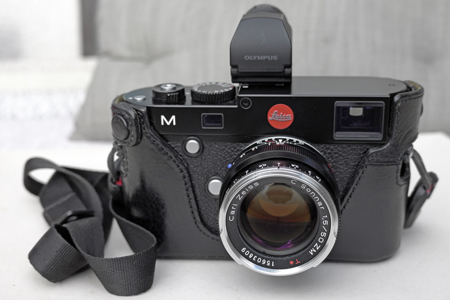Leica M (Typ 240) - First Impressions
First Comments from Others | Some First Comments by Me | It's all there! | Some of My Settings | Weight and Size | Lenses | What Is Missing or Could Be Improved (in My Opinion)? | Conclusions
Archive
On this page, I would like to give away my first impressions of using the Leica M (Typ 240) camera. I will also briefly refer to my rangefinder lenses that I took over from the Ricoh GXR, but, for details on the lenses, see the respective lens pages (overview).
First Comments from Others
When I showed the Leica M (Typ 240) to my friend and his son, both are photo enthusiasts and the son wants to become a professional photographer, I got quite a few comments on my camera. One comment was that I am now a "retro" photographer, doing without all the modern achievements like blazingly fast autofocus, 5-axis image stabilization, 4k video, and more of the like. Another one was on the camera's weight. The camera may not be huge compared with full-frame DSLRs, but it is indeed very heavy. I will come back to this further below. And then the son asked me, whether I am not anxious of being robbed or of dropping such an expensive camera. Yes, I am. But I will try to be cautious - that's all I can do now. Well, I could indeed do more and replace the red dot with a black one (yes, you can buy this...) or just glue black tape over the red dot.
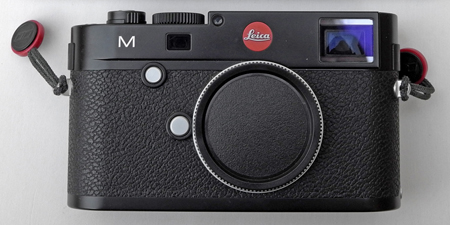 |
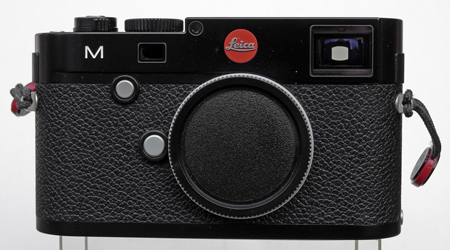 |
Photos: My Leica M 240 from eBay after unboxing
Admittedly, I haven't told most people yet that I own a Leica M (Typ 240). They would either scold me, because I spent so much money on a camera, or they would laugh at me, because other cameras are much better for a lot of less money. And when people detect the Leica hanging on my shoulder, they often like to make some funny comments, typically more of the second type (because they are knowledgeable photographers). You obviously have to stand this as a Leica owner.
Some First Comments by Me
So what can I say about the Leica M (Typ 240) after about three months of use? First, you have to get used to it. Second, here are some first observations:
- I use the camera 95% of the time in live view mode. Only when the battery power gets low, I switch to rangefinder mode to save energy.
- Most photographers seem to hate the external viewfinder. I know that it is not very practical when you put the camera in a bag, but I like to tilt it 90 degrees. I use this feature very often and would be disappointed not having it (a tiltable LCD screen would also be welcome in some situations...).
- Compared with a Sony or Panasonic (or Ricoh, but that's another affair...), the camera is "simple" or even "simplistic". But the main point (or "the essential" as the Leica advertising recently promotes...) for me is, that most of what I need is easily and quickly available: It's all there! I will explain what this means in the following...
- I shoot primarily in JPG, but some "difficult" lenses (my wide angle lenses below 50 mm, but particularly the Voigtländer 15 mm and the Zeiss 21 mm lenses) may force me to use DNG (RAW) so that I can correct the color shading that these lenses produce.
- The Artisan&Artist half case is nice and practical for holding the camera, but is disturbing whenever I need to transfer images to the computer or to charge the battery - I have to remove the case from the camera each time. You also have to remove it when you want to put the camera on a tripod. Maybe, there are more practical halfcases from other manufacturers (the camera came with this halfcase)...
- Dust on the sensor has again become an issues for me... I am still in the process of leaning how I can get rid of it (with dry and wet methods).
- My computer's hard disk is getting full now much earlier, because of the 24 MP sensor and thus, larger image files.
- It is indeed heavy. For details see below... But this makes perhaps an in-built stabilization feature superfluous - the camera lies already stable in your hands!
Photo: My Leica M 240 fully equipped with normal lens (Zeiss Sonnar 50mm f/1.5) - about 1060 g heavy...
It's all there!
When using the Leica M (Typ 240), I have to say that "it's all there" what I need:
- Focusing: Is manual, set at the lens by turning the manual distance ring - and needs some practice. But using the magnification and focus peaking (which is fairly unobtrusive on this camera), I am successful most of the time (wide angle lenses can be a challenge, though...).
- Aperture: Is selected manually at the lens (aperture ring).
- Shutter speed: Mostly, I use the camera in "A" mode, that is, time is set automatically. But switching to manual mode is easy thanks to the shutter speed dial on the camera top.
- ISO: Can be easily accessed using the "ISO" button on the left side of the camera back. You need to know, though, that you have to press the "ISO" button all the time while you turn the setting dial/thumb wheel (contrary to the Leica X Vario). But once you know this, it's OK.
- Exposure compensation: Can now be easily set using the setting dial/thumb wheel (since firmware update 2.0.1.5). You can also lock exposure by half-pressing the shutter release button, which I use fairly often. AF lock is not necessary for manual focus.
- Screen magnification: Is set to automatic by me and activated when I turn the lens's distance ring (except for wide angle lenses, where this sometimes does not work). Changing the magnification with the setting dial/thumb wheel is convenient. After some training, I can now also use the "focus" button at the front of the camera.
- Horizon: Can be activated in the "Display" menu, I use it most of the time (since firmware update 2.0.1.5)
- Zone focusing and hyperfocal distance: I just use the DOF markers on the lens. See here.
- Self-timer: Is rarely used, but on the main switch easily found. The time has to be changed in the menu, though...
Much more I (usually) do not need...
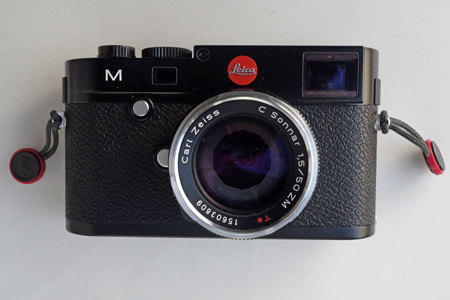 |
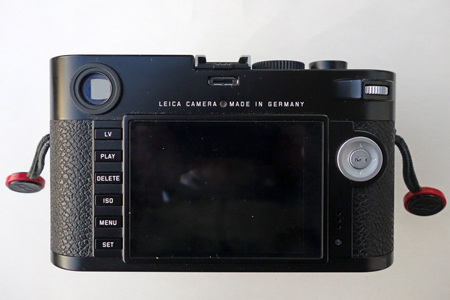 |
Photos: Views of Leica M (Typ 240) with Zeiss 50mm f/1.5 lens from front and rear
Some of My Settings
Favorite camera settings vary from photographer to photographer and also depend on the situation at hand. Therefore, it is difficult to recommend camera settings to other people. Nevertheless, I list some settings that I typically use - maybe, they offer one or the other inspiration for others:
- Image Format: JPEG fine, 24 MP
- ISO: Between 200 and 800 (often between 400 and 800), when it is dark ISO 1600, rarely ISO 3200
- Exposure Simulation: "Re. half pressed" so that exposure is only simulated when I half-press the shutter button. "Permanent" exposure simulation was added in firmware update 2.0.1.5., and I thought that I would go for it. But after a while, I realized that I preferred it the "original" way.
- Lens Detection: Usually "Off". This may change, however, one day...
- Exposure Compensation: Usually 0, sometimes -0.3 or even -0.7. Other values in special situations. I had set my previous cameras often on EV -0.3 to avoid blown-out highlights, but the full-frame sensor is "better behaved" in this respect...
- Direct (Exposure) Adjustment: "On" so that EV can be changed by turning only the thumb wheel/settings dial (possible since firmware update 2.0.1.5.).
- Light Metering Mode: "Classic". At the beginning, I used "Advanced > Multi-field", later "Advanced > Center-Weighted", and in the end "Classic" which is also (strongly) center-weighted but does not depend on live liew.
- Live View Mode: "On" (most of the time)
- White Balance: Auto
- Acoustic Signal: "Off" (default)
- Contrast, Sharpness, Saturation: Standard
- Frameline Color: White
- Focus Aid: "Automatic" = As soon as you turn the focusing ring on the lens, the enlarged detail appears (the enlargement factor can be changed using the thumb wheel). You can also use the focus button to turn on enlargement manually (for example, if you do not want to change the distance setting).
- Focus Peaking: "Red" (color choice possible since firmware update 2.0.1.5.)
- Horizon: "On"
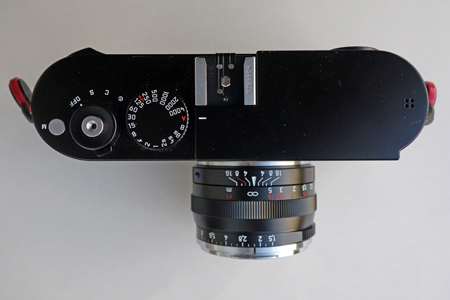 |
Photo: Top view of Leica M (Typ 240) with Zeiss 50mm f/1.5 lens
Weight and Size
The Leica M (Typ 240) is indeed heavy (body: 680 g, with Zeiss "normal" lens and "fully equipped": 1060 g). The M-mount lenses aren't light-weight either, because they are made of metal, not plastic. All this adds up to more than I am usually willing to carry around with me (see my introduction to the Ricoh GXR and why I bought it...). The camera with a lens hanging over my shoulder plus a bag with two or three lenses is too heavy for me after an hour or so. Usually, I carry only the camera with a lens over my shoulder, and sometimes another lens or two in my pockets.
All in all, weight-wise, the Leica M (Typ 240) is not my "ideal" camera. Now, I appreciate how "light" the Leica X Vario is (which is still heavy enough for me).
The Leica M (Typ) is not a pocketable camera, neither is the Leica X Vario (which, although officially announced as a "Mini-M" is not much smaller...).That's why I bought the Ricoh GR, although it has only a fixed 28 mm (equiv.) lens and lacks a viewfinder. But nobody would expect a Leica to be a pocket camera, I assume...
Size and weight comparisons can be found here.
Lenses
Ken Rockwell states in his test of the Leica M (Typ 240) that you should not spoil your expensive Leica with cheap Voigtländer (and other) lenses. Well, this is just what I do (my Zeiss lenses may be an exception...). As far as I see it, my lenses are still "good enough" for me, but experience will show where the quality differences between the lenses lie.
And, to my dismay, I also had to realize that all the wide angle lenses (lenses below a focal length of 50 mm) that I own show more or less color shading, thus, need more or less image correction. This can be done, for example using an application like CornerFix, but it requires me to use the DNG format, whereas I am a "pure" JPG shooter normally. At the end of 2016, I decided to part from my three lenses with the shortest focal lengths (15 mm, 21 mm, 25 mm) and replace these with lenses that produce no or only little color shading.
I have also read in the forums that the Leica M (Typ 240) JPGs are quite OK (some posters even complained that they were not able to reproduce the look of their JPG files in RAW).
More information about my M-mount lenses can be found on the respective pages for the lenses.
What Is Missing or Could Be Improved (in My Opinion)?
I am well aware of the fact that Leica is more or less "deaf" when I make suggestions for improvement - at least, this was the case for the Leica X Vario. I am also aware of the fact that there were two major firmware updates, in which Leica definitely improved the M, and now, reaching the end of its "life cycle" as a "current" product, it is highly improbable that Leica will release any further firmware updates with some more improvements. Nonetheless, I list a few things below that could be improved on the Leica M (Typ 240).
Taken from the Leica X Vario:
- Zoom setting in automatic review ("Auto Review"): The image is displayed enlarged after 1or 2 seconds so that you can easily see whether it is sharp.
Taken from the Ricoh GXR:
- More users settings for saving lens data/settings (name, focal length, corrections, ...); 12 settings would be welcome (they might be stored on the SD card, as the GXR does in part)
- The ability to manually set vignetting and color shading options for a lens and to save these (see here how the GXR does it).
My own proposals:
- The option to move the enlarged section within the image using the directional pad.
- The option to use the video shutter release button as function button that can be customized by the user (function selection in the menu).
- The option that the user can assign menu functions to the "SET" menu (or remove them from the menu)
- Battery with less weight but the same or even higher capacity
Conclusions
These are just a few preliminary ideas, comment, habits, opinions, and so on. This page will therefore change and perhaps also grow a little over time...
| 04.07.2024 |
